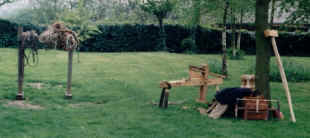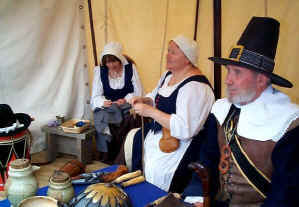
- The Siege group
- Home
- Who we are
- Living History
- On the Camp
- Costume
- 2007 Events
- News
- Membership info
- Picture Gallery
- Contact us
- Links
- Yahoo Group
- Site Credits
- The 17th Century
- Music
- Cookery
- Handicrafts
- Children
- Games
- Weaponry
- The Civil War
Handicrafts
During the 17th century, it was essential that every man and woman had a skill in handicrafts, since only the nobility had servants to do the work for them.
Many of the men worked on the land, which often meant they had some skill with wood, for instance mending fences and hedgerows, coppicing or charcoal burning.
 They would rely on the local smith to
make tools for them. These tools could be used by the more skilled
woodworkers for turning and shaping wood on
a pole-lathe
or
a shave-horse. Many wooden items can be made on the
shave-horse. These include tent-pegs, dowels and wedges, tool-handles,
crutches and spokes for wagon wheels.
They would rely on the local smith to
make tools for them. These tools could be used by the more skilled
woodworkers for turning and shaping wood on
a pole-lathe
or
a shave-horse. Many wooden items can be made on the
shave-horse. These include tent-pegs, dowels and wedges, tool-handles,
crutches and spokes for wagon wheels.
Such woodworkers were named 'bodgers', which at the time was a term for a skilled man but has now become a term of abuse meaning an incompetent worker.
The smith would work with iron to make and mend items such as blades and armour along with more mundane items like the many fastenings for wagons. He would use a forge to heat the metal until soft enough to beat with a hammer, to bend and pierce it. It would then be tempered (hardened) by plunging into a pail of water.
 The
women-folk busied themselves mending clothes and making new garments,
often using material recovered from old ones. Recycling is not a new
idea!
The
women-folk busied themselves mending clothes and making new garments,
often using material recovered from old ones. Recycling is not a new
idea!
Clothes were often passed on or handed down to other members of the family.
New clothes were always needed by the men who toiled daily in the fields. They were quickly worn out carrying burdens in all weathers and needed to be replaced when they could no longer be mended. The clothes worn by ordinary people were coloured but did not have elaborate decoration. Only the better-off would embroider or make lace decoration for their garments.